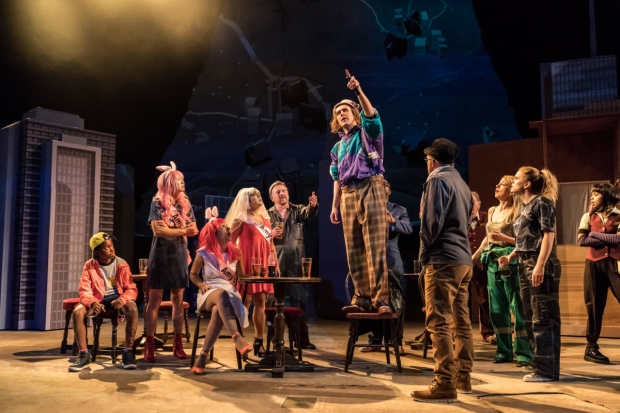Dragon fights and doll houses: designing the Olivier stage for Saint George and the Dragon
Designer Rae Smith explains how she created the hand-drawn aesthetic for Rory Mullarkey’s new play

© Johan Persson
The design for Saint George and the Dragon began as the show was being workshopped at the NT’s New Work Department; it was there that I heard the story for the first time. As a new play forms, the design begins to realise itself, reacting to the imagination of the actors and the clues in the text. It's a very different process to designing a set text or a classic work.
You are never alone when designing a piece of new work – this set was about continually working with the director Lyndsey Turner, the actors, and playwright Rory Mullarkey. Therefore you have to keep making simple strong decisions which help the storytelling. Your job as the designer is to help the play be buoyant, articulating and supporting the work of the actors, the vision of the director and to keep the story moving.
I manipulated the buildings to make the characters bigger than they are
Throughout the story of Saint George, the characters move between three very different locations; 'Medieval', 'Victorian' and 'today'. I needed to create those three environments in the one play. I began by looking at the work of Rebecca Whiteread – she creates beautiful 'mini-me' British doll houses, which was a good starting point for the design. The way the design evolved, the three different locations are 'told' through three different hand-drawn aesthetics appropriate to the era. The medieval houses are woodcut, as though they’ve been chiselled by hand. Then the Victorian era looks like a lithograph or a Dickens illustration – it feels inky. Then the world today has the quality of a graphic novel.
All hand drawn, the three locations are intrinsically important to the story. Each environment has a sense of scale, reflected in the relationships and lifestyles in the story. By telling the story through drawing rather than documentary realism, for example, the set gives an atmosphere the audience recognise, but they are not being ‘told’ what to see. There is a space for them to fill in the gaps in the design. Audiences can recognise a feeling for a place more readily when it is drawn than photographed; they connect with it, it feels familiar.
The audience fill the gaps in the design, they connect with it

© Johan Persson
Saint George and the Dragon is a journey in time, but also in scale, and more specifically inversion of scale. I wanted to make the characters bigger than they are, and I did this by manipulating the scale of the buildings that surround them. This helps us see and hear the actors clearly in the huge space of the Olivier. Another key theme in the show which is reflected in the design is building and making. It’s what people like to do – they make things together. Lyndsey has such a clear idea of what she is doing, and so making and building was integrated into the design and the direction as the characters move in time.
The projected map at the back of the stage is a way of talking about England's history and geography. The playing space blends into the sky, and as you watch the town function on the stage, you simultaneously get a plan view of the village, town or city. It gives the audience a social-anthropological viewpoint, and takes you from walking around the community to a 'dragon’s eye view' in one smooth sweep. Betsy Dadd (projection designer) has contributed beautifully to this story’s visualisation.
The dragon fight was a design element I was particularly excited to develop, and without giving anything away, watching people watch that scene for the first time is tremendously satisfying, as the story is punctuated with some humongous monster business!
Saint George and the Dragon runs at the National Theatre until 2 December.














